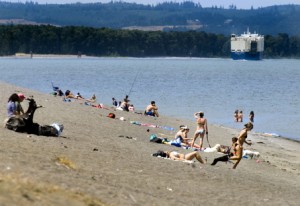 Nowadays the island at the confluence of the Willamette and Columbia Rivers, is referred to as “Sauvie Island”, or sometimes “Sauvie’s Island” by the older residents. It’s a favorite spot for Portlanders to cycle, to hunt water fowl, or even to go skinny dipping in the summer months. But historically, t
Nowadays the island at the confluence of the Willamette and Columbia Rivers, is referred to as “Sauvie Island”, or sometimes “Sauvie’s Island” by the older residents. It’s a favorite spot for Portlanders to cycle, to hunt water fowl, or even to go skinny dipping in the summer months. But historically, t his low-lying island within the tidal pull of the ocean has been associated with several other important local entities, which far exceeded the humble contributions of the cow-herding Laurent Sauvé.
his low-lying island within the tidal pull of the ocean has been associated with several other important local entities, which far exceeded the humble contributions of the cow-herding Laurent Sauvé.
Wapato Island:
Although this island serves only as a recreational footnote to the region today, it was the absolute epicenter of human habitation for thousands of years in the past. In what is now known as Sturgeon Lake and in all the bayou-esque waterways that serve as 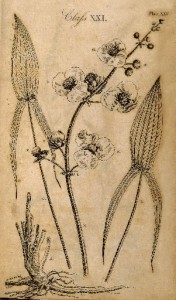 the intestinal tract of Sauvie island’s aquatic landscape, there resides an aquatic plant that sports a large bulbous head to anchor it to the muddy lake bed. Known to the Indians as “Wapato” or Broad-leafed Arrowhead (Sagittaria latifolia) to the Europeans, this underwater tuber was a great favorite of the Indians. The huge popularity of this unlikely onion, and the presence of huge volumes of salmon had the effect of concentrating the Indian population – making the lower Columbia one of the most densely populated areas in the entire north American Continent. It is thought that prior to the arrival of European epidemics in this region, the Lower Columbia supported a population of more than 60,000 Indians, who consumed as much as 41 million tons of salmon and well as vast quantities of Wapato.
the intestinal tract of Sauvie island’s aquatic landscape, there resides an aquatic plant that sports a large bulbous head to anchor it to the muddy lake bed. Known to the Indians as “Wapato” or Broad-leafed Arrowhead (Sagittaria latifolia) to the Europeans, this underwater tuber was a great favorite of the Indians. The huge popularity of this unlikely onion, and the presence of huge volumes of salmon had the effect of concentrating the Indian population – making the lower Columbia one of the most densely populated areas in the entire north American Continent. It is thought that prior to the arrival of European epidemics in this region, the Lower Columbia supported a population of more than 60,000 Indians, who consumed as much as 41 million tons of salmon and well as vast quantities of Wapato.
In 1806, Lewis and Clark stopped by the village of Cathlapotle, located in what is now the Ridgefield National Park just north of Vancouver. There they camped at a local portage where the Indians carried their canoes to an inland pond. In their journals they described what they found:
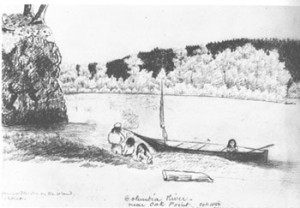 “in this pond the nativs inform us they Collect great quantities of pappato, which the womin collect by getting into the water, Sometimes to their necks holding by a Small canoe and with their feet loosen the wappato or bulb of the root from the bottom from the Fibers, and it imedeately rises to the top of the water, they Collect & throw them into the Canoe, those deep roots are the largest and best roots”.
“in this pond the nativs inform us they Collect great quantities of pappato, which the womin collect by getting into the water, Sometimes to their necks holding by a Small canoe and with their feet loosen the wappato or bulb of the root from the bottom from the Fibers, and it imedeately rises to the top of the water, they Collect & throw them into the Canoe, those deep roots are the largest and best roots”.
As evidenced by Lewis and Clark’s own purchases of this plant to feed their expeditionary force, Wapato was a hugely important staple. According to them the very best roots could be found on the island just across the river from Cathlapotle, which they named Wapato Island.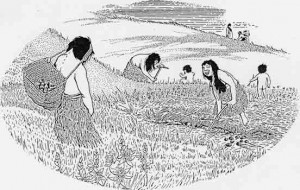
“Wappatoe Island is … high and extreemly fertile … with ponds which produce great quantities of the … bulb of which the natives call wappatoe … we passed several fishing camps on Wappetoe island …”— Meriwether Lewis, March 30, 1806
Considering the prominence of those that bestowed this moniker, one would think that we would still be calling it Wapato Island, but one would be wrong!
James Wyeth’s Fort William:
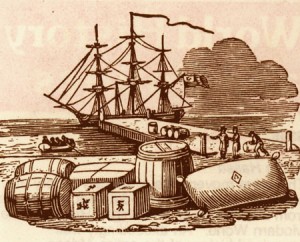 The next two decades were devastating to the Indian populations living in the area. The arrival of smallpox, syphilis, measles and tuberculosis decimated the native peoples. In 1829 a devastating epidemic known as “the ague” swept across the land. In less than two years these “intermittent fevers” had killed most of the local Indian population on the island. In 1834 Nathaniel Wyeth arrived and established Fort William at a point where a historic Indian trail intersected with the Multnomah Channel. However, the venture was fated to fail as most of the beaver in the region had already been trapped, and efforts to rely on trade in
The next two decades were devastating to the Indian populations living in the area. The arrival of smallpox, syphilis, measles and tuberculosis decimated the native peoples. In 1829 a devastating epidemic known as “the ague” swept across the land. In less than two years these “intermittent fevers” had killed most of the local Indian population on the island. In 1834 Nathaniel Wyeth arrived and established Fort William at a point where a historic Indian trail intersected with the Multnomah Channel. However, the venture was fated to fail as most of the beaver in the region had already been trapped, and efforts to rely on trade in 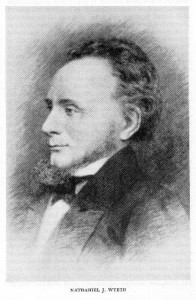 agricultural goods proved fruitless. Wyeth’s hired Hawaiian laborers promptly decamped taking most of the horses. This was compounded by a murderous dispute involving the Fort’s gunsmith and tailor over the affections of a local Indian girl. The fact that the island was often submerged in the swollen river waters contributed to the unhealthy environment. Standing water on the island was a breeding ground for much sickness, and there was little food. After 17 of his men died of “bilious disorders” Wyeth finally abandoned Fort William, writing in his journal that by that time they were “living off of trash and dogs.”
agricultural goods proved fruitless. Wyeth’s hired Hawaiian laborers promptly decamped taking most of the horses. This was compounded by a murderous dispute involving the Fort’s gunsmith and tailor over the affections of a local Indian girl. The fact that the island was often submerged in the swollen river waters contributed to the unhealthy environment. Standing water on the island was a breeding ground for much sickness, and there was little food. After 17 of his men died of “bilious disorders” Wyeth finally abandoned Fort William, writing in his journal that by that time they were “living off of trash and dogs.”
Laurent Sauvé:
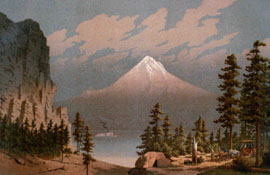 In 1837, McLoughlin, the Chief Factor of the Hudson Bay Company, entered into an arrangement to supply the Russian settlements in Alaska with butter. This led to the decision to establish a dairy herd on the Island – at the site of the ill-fated Wyeth venture. Around 400 cows were swum across the Columbia river from Fort Vancouver. According to some sources, McLoughlin chose a young Orkney-man to run the operation, James Logie. But James has a sweet-heart back in the isles that he wished to marry, so the Hudson bay Company gave him leave to return to England to marry, after which he planned to return to the Pacific Northwest with his 16 year old bride, Isabelle. In the interim, Dr McLoughlin assigned another HBC employee, Laurent Sauve, to care for the herds.
In 1837, McLoughlin, the Chief Factor of the Hudson Bay Company, entered into an arrangement to supply the Russian settlements in Alaska with butter. This led to the decision to establish a dairy herd on the Island – at the site of the ill-fated Wyeth venture. Around 400 cows were swum across the Columbia river from Fort Vancouver. According to some sources, McLoughlin chose a young Orkney-man to run the operation, James Logie. But James has a sweet-heart back in the isles that he wished to marry, so the Hudson bay Company gave him leave to return to England to marry, after which he planned to return to the Pacific Northwest with his 16 year old bride, Isabelle. In the interim, Dr McLoughlin assigned another HBC employee, Laurent Sauve, to care for the herds.
James and Isabelle Logie:
In 1842, after nearly a two year absence, James and his young bride took up residence on the island and began to develop several diaries located on the island, and across the Tualatin Mountains in the vicinity of Dairy Creek. Isabelle Logie was the first white woman to reside in Oregon, and at the tender age of 16 she must have been a remarkable 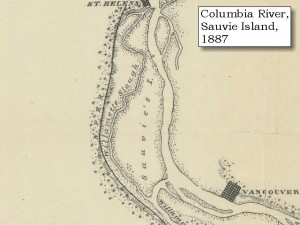 woman to plunge into a life in the wilderness so far from home. Shortly after arriving, she was formally trained by Dr. Forbes Barclay of the HBC, and she subsequently became active in tending to the desperate medical afflictions of the natives, who were gradually been exterminated by the European illness for which they had not resistance. The Logie’s remained the center of the island community, and they eventually assumed ownership of the dairy after the Hudson Bay Company moved their headquarters to Victoria. Isabelle returned to the Orkney’s once, but soon returned to her new home on the island. In 1854, James was stricken with Typhus, and despite valiant efforts to get him medicines from Portland he succumbed to the disease that had taken so many of his native natives.
woman to plunge into a life in the wilderness so far from home. Shortly after arriving, she was formally trained by Dr. Forbes Barclay of the HBC, and she subsequently became active in tending to the desperate medical afflictions of the natives, who were gradually been exterminated by the European illness for which they had not resistance. The Logie’s remained the center of the island community, and they eventually assumed ownership of the dairy after the Hudson Bay Company moved their headquarters to Victoria. Isabelle returned to the Orkney’s once, but soon returned to her new home on the island. In 1854, James was stricken with Typhus, and despite valiant efforts to get him medicines from Portland he succumbed to the disease that had taken so many of his native natives.
So despite his dozen years of building up the island’s dairies and establishing the foundation of the new community growing there, the island would still be called after the name of the Hudson Bay employee that had been temporarily installed during his two year absence.

Hi Jim –
Great article! I am a descendant of Isabella Moar and would like to discuss more about your research on the Logie story with you!
Did I write back to you in response to your comment? I would love to talk to you about your ancestry and the local history. Please call me at 503-860-3297 when it’s convenient. otherwise email me at jim@thayers.org
Jim
I saw the surname “Mohr” in your post. Is there any connection to Jonathan Mohr? (not sure of the spelling of his first name) My great-great-grandfather, Malcolm Mckay, traveled with a Jonathan Mohr from Orkney, across Canada, to Ft. Vancouver around 1847.
Logie was an Orkney-man, but I don’t recall having come across a “Jonathon Mohr”.
Jim Thayer
Hey Bert
James Logie was Isabella Millers-Logie-Moar’s first husband. Jonathan Moar married Isabella shortly after Mr. Logies sudden death. I would like to discuss more with you on the subject please email me at camelot43@gmail.com
Jonathan Moar is my 3rd great grandfather
-Logan
Jonathan Moar is my great-great-great grandfather, I’m related to his daughter with Isabella, Margaret.
Hi Sarah!
How awesome! I have lots of our family history and photos that I would love to share but I do not have much information on Margaret and her descendants. I am down the line of Jonathan Moar Jr.
Very nice to meet you, please email me Camelot43@gmail.com
I am a descendant of Isabella and Jonathan Moar – their daughter Margaret who married Charles Wilson is my great-great grandmother 🙂
I really enjoy your work on this website. I have a question that relates to the painting above. I’m trying to find information about a painting that I believe is Mt. St. Helens and has been in the family for a long time, but has a forgotten history. The artist is not famous enough for me to find on the internet. His signature is Brink and I’m guessing it is at least 100 years or older. Thank you for any help you can offer. Brian
Unfortunately, I did not get the attached picture; you could sent it to me at jim@thayers.com.
Jim
Jim, great article. As an employee of Scappoose Bay Kayaking I am always trying to find new and interesting things to mention and talk about for tours that we provide of Scappoose Bay, Cunningham Slough and Warrior Rock. This page has been a wealth of information for me and our shop. I had no idea about the elaborate and behind the scenes naming of Sauvie’s Island or the existence of James and Isabelle Logie (Is Logie Trail of Hwy 30 named after them? It would seem likely, yes?) Thank you for your dedication in your research and creation of this page and site. Please at anytime call us down here at the shop (503-397-2161) email at info@scappoosebaykayaking.com or come in and visit us, you would be most welcome. -Andy
Bert:
Logan asked me to post this note to you about Isabelle’s second husband: Moar.
Herewith his note:
Hi Jim –
I really enjoyed the Sauvie Island article! As you are well aware Mr. Logie had been placed in charge of the Dairy after Laurent Sauve’s time there. From what I understand he was sort of second in charge at that time and was a natural fit to take charge for the HBC. Much like Logie was Sauve’s right hand man, Jonathan Moar who was a blacksmith for the HBC became Mr. Logie’s second in command.
In 1854 James Logie was sick with Typhus and as the story goes Jonathan Moar swam a horse across the slough to get aid in Portland. Unfortunately he was too late and after nearly drowning himself was unable to get the medicine to James in time.
A few short months later Jonathan Moar had married James’ wife Isabella Miller. Isabella was given right to the Donation Land Claim originally filed by Mr. Logie and Jonathan Moar took over the duties of the Dairy.
I am the 3rd great grandson of Jonathan & Isabella Logie-Moar. I take care of the cemetery on the island as it is a special place.
Ironically James & Isabella can be found in the 1850 census listed under James & Isabella Logan which was unknown at the time that I was named.
If you wouldn’t mind forwarding my information onto Bert Van Laer I would appreciate it. I would love to hear what he has found and share what I have!
Sincerely
-Logan Clark
Hi Jim, I love that the Sauvie Island section and wonder what the source of the Broad Leafed Arrowhead plant drawing is. I would love to get a hi-res copy.
Joe